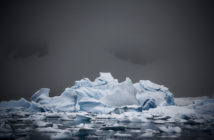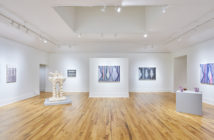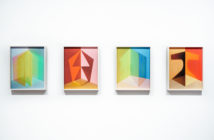Stills from Pierre Huyghe’s 19-minute video, Untitled (Human Mask) have haunted me since its 2014 debut. The image of the ghostly porcelain face touched ever so gently by the impish hairy hand has appeared and reappeared before me in magazines and book covers. So it was with great anticipation that I entered the Bell Gallery through dark, unwelcoming curtains.
Entering the gallery, the sensation of near complete darkness was overwhelming, save for the gallery attendant’s lone desk lamp and the dim outline of the suspended screen. Slowly making my way toward the viewing area on the far end of the gallery, I was reminded of a cave tour when the guide turned off her flashlight and asked us to hold our hand in front of our face: a visually impossible task with the surreal cognitive effect of preserving our physicality without sight. The film, itself dimly light with a green and dusk-like quality, continued the effect of visual and mental disconnect as I sat on the black carpeted viewing area.
In the film, a diminutive figure wanders an abandoned restaurant somewhere in Japan, the crumbling ruins of the double-edged Fukushima disaster lending a post-apocalyptic tone. She is dark haired, dressed in a simple dark dress, but her face is a blank, near-expressionless, porcelain shell. Her limbs are hairy, not furry, but animal nonetheless. The setting wavers in between domestic and commercial, mimicking our protagonist’s eerie shift between human and animal.
The divide is perceived yet questioned. We know we are watching a monkey masquerading as a human girl, but sublet gestures and postures seem to betray a humanity. She taps her foot, patiently waiting for we don’t know what. She absentmindedly plays with her hair or nimbly, lazily cleans dirt from under her thick, claw-like fingernails. Throughout the duration of the film, we are given a creature who seems to be apathetic about her circumstance. This perceived attitude, combined with the human-like gestures and topped with mask, wig and outfit, create unstable character that we instinctively anthropomorphize, overlaying her with our human qualities and emotions, yet she continually pushes us away with a close-up of an alien foot, a furred arm or the disarming twinkle of beady black eyes behind the almond slits of the mask.
The gallery’s interpretation of the piece does well at giving some background to the piece without betraying any secrets. Included here is a quote from the artist describing the protagonist as a “trained servant; unconscious actor of a human labor and a drone”. This is a clue about the monkey, but also a play on words, as a drone was used to achieve the panning exterior shot from within the exclusion zone. The idea of the machine is one that we are reminded of with repeated shots of multiple maneki-neko, the plastic cat figurines’ paws ticking away like metronomes. We see them juxtaposed with a living cat whose aloof manner is not unlike that of the monkey in the mask. The drone, the mechanical cat, the monkey broken of its more animal behaviors to please a human audience, cycle in and out of the film dragging up Descartes’ antiquated yet still provocative theory of the animal sharing more in common with a pocket watch than with ourselves. Huyghe’s film pushes against this notion and brings our attention to it, suggesting we have yet to fully evolve our thinking.
Huyghe’s continuously looping film acts as a dark and uncanny meditation on the human, the animal, and the machine. The gallery is devoted to this single piece, and the installation is designed to facilitate the meditative qualities of the piece; the approach through darkness, the black carpeted floor seating area on which it feels natural to sit cross-legged, hands folded in the lap all accentuate this. However, these well-calculated attentions to the space are interrupted by the attendant and the desk lamp, which casts a well-lit pool of distractions just below the screens right corner. Considering the gallery’s previous exhibitions, I was somewhat perturbed and left wondering why this compromise was made or how it could be resolved. Although, after a time I did sink into the state of mind the film requires and it was well worth having waited these three years to see in person.
Untitled (Human Mask) flips back and forth between multiple dichotomies, some more obvious and others more obscured. The piece lets these slip back in and out of our consciousness before some small detail jolts us back into rationalizing what is before us and ask what it is we are actually seeing. Is the hand we are holding up in the darkness really there and is it even our hand after all?
Untitled (Human Mask) is on view through May 28th




